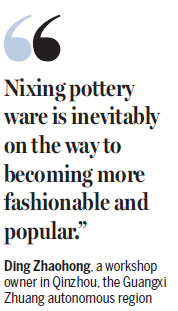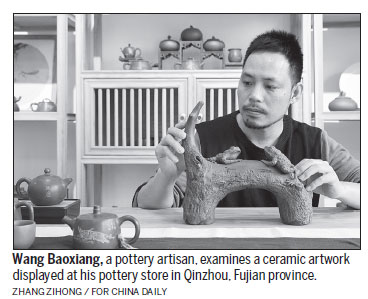Nixing pottery: Historic, beautiful - and profitable for craft industry
Nixing pottery, a well-preserved traditional craft with a history stretching back more than 1,300 years, still shines today.
Qinzhou, a city in South China's Guangxi Zhuang autonomous region, is the birthplace of the pottery. Local artisans and craftsmen stick to the time-honored craft and polish their technique, adding glamor to the State-level intangible cultural heritage.
Pottery has a long history of use in China as a basic necessity. Today, it is still common to see Chinese people use pottery for tea kettles and stewing pots. Others collect the pieces as artwork and decorations.
Nixing pottery is unique for several reasons, chief among these being the clay, dug up from the banks of the Qinzhou River by local residents.
After approximately 80 processes, including milling and screening, the clay is formed into perfect shapes, and craftsmen engrave flowers, figures, landscapes or excerpts from Chinese classic literature onto smooth surfaces, then fire them up.

Pottery is simpler and more plainly decorated than porcelain, but Wang Baoxiang, an experienced Nixing pottery artisan who also runs a workshop at the city, noted that without any addition of pigment or layers of glaze, the beauty of Qinzhou's pottery is not inferior to porcelain.
Another key factor in the pottery's unique nature is the use of the Yaobian, a furnace rarely seen in the domestic ceramics industry.
Throughout the firing process, a large group of minerals contained in the clay - iron, zinc, calcium and strontium - will wind up giving the finished work the colors of bronze, purple and gold, or a tiger-line pattern.
Nixing pottery works won a gold medal at the World Exposition held in the United States in 1915, according to historical records provided by Nixing Pottery Museum.
In 2008, the techniques of making Nixing pottery were listed by China as a Statelevel intangible cultural heritage.
Qinzhou natives have made key breakthroughs in protecting the traditional craft by releasing supportive policies and protection regulations. Today, local officials say, more than 10,000 people are working in the Nixing pottery industry.
Currently, a total of 536 companies and workshops are engaged in the Nixing pottery industry in Qinzhou, generating 1.2 billion yuan ($172.96 million) in total output value from January through October, up 30 percent year-on-year.
The Millennium Ancient Pottery Town, a ceramics industrial park, was planned in 2012 with a total planned investment of 1.56 billion yuan. At present, 920 million yuan worth of investment has been put into operation.
"Thanks to the strong attachment of Chinese people to tea, Nixing pottery ware is inevitably on the way to becoming more fashionable and popular," said Ding Zhaohong, a workshop owner in Qinzhou.
liyou@chinadaily.com.cn

(China Daily 11/29/2018 page17)














